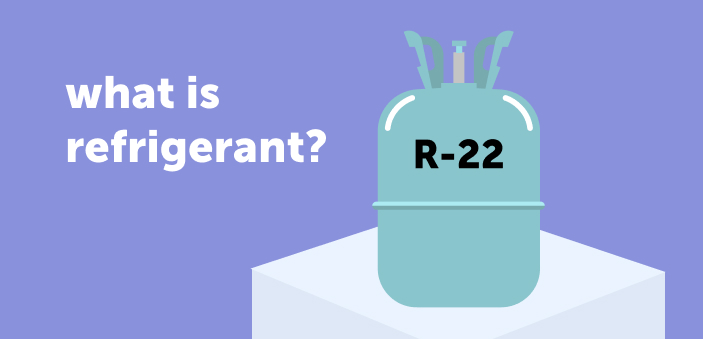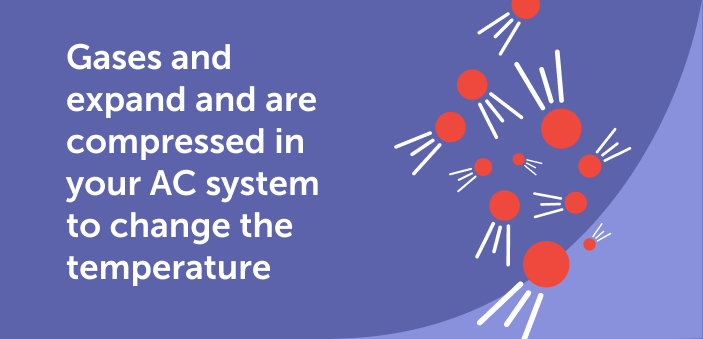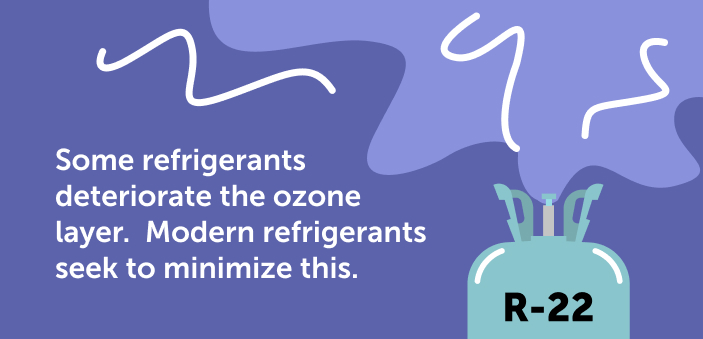What is refrigerant?
Refrigerants are somewhat mysterious to those of us who do not work in the HVAC industry. What are they made out of? How do they work? What are the drawbacks?

Refrigerants are not as enigmatic as they first appear. By the end of this article, you’ll know just about all there is to know about refrigerants. Let’s start with some basic definitions.
Characteristics of Refrigerants
The dictionary definition of refrigerant is “used for refrigeration”. Okay, that’s extremely vague. With that definition, ice could be considered a refrigerant.
However, in the practical world, the true definition of refrigerant is considerably more specific. It’s also considerably more complicated.
A refrigerant is a liquid or gas that behaves as closely to an ideal gas as possible. This substance is used in conjunction with compressors and expansion chambers in order to reduce the temperature of another substance.
Wait a second… ideal gasses? Compressor and expansion chambers? Why did this turn into a science class?
We will be getting a little technical, but I promise it won’t be too bad. It will also be very interesting. Let’s get into it!
How does refrigerant work?
We have to start with something called the ideal gas law. This is not a man-made law, of course, but a physical one. It is inherent in the way our universe exhibits forces.
An ideal gas, by definition, is a gas wherein distinct atoms do not attract or repel or each other with electromagnetic forces, and occupy single points in space. This simplification allows us to more conveniently calculate the properties of a given amount of gas. Namely, because of the predictable manner in which these individual ideal particles collide, we can calculate three specific things. First, we can calculate the pressure - a numeric measurement of the force with which the particles expand outward. Second, we can calculate the volume, or how much space the gas takes up. Finally, we can calculate the temperature of the gas.
The ideal gas law gives us the relationship of these measurements as PV = nRT, where P equals pressure; V equals volume; n equals the number of particles; R equals an pre-derived constant (8.3145 joules per molar kelvin); and T equals temperature.
Given every other value in the equation, we can discover any of these values. For example, if we know the pressure, the number of particles, and the volume, we can calculate the temperature of the gas.
This model also gives us a description of how changes in one of these properties affects the others. For example, if we increase pressure, we see that temperature will increase proportionally. All else held constant, increasing volume will increase temperature, and so forth.

We should note that ideal gasses do not exist in the real world. Real atoms have a volume. Often, they have electric charges which generate forces between each other. There are also strong and weak nuclear forces that contribute to non-idealism. The less ideal a gas is, the less it responds to the properties of the ideal gas law. This brings us to why we use refrigerants.
Refrigerants are composed of particles that behave as close to ideal gasses as possible in the real world, and as practical in the manufacturing world. To accomplish this goal, engineers design and manufacture a number of different compounds. The first, chlorofluorocarbons (CFCs), have been used in many different applications for decades.
A CFC molecule is characterized by chlorine atoms, fluorine atoms, and carbon atoms linked together in varying structures.
Because of the properties of the substance created by the bonds of these atoms, we find that they behave as closely to ideal gases as is possible and practical. This translates to extraordinary efficiency in the process of cooling and warming the refrigerant. If we used, say, water as a refrigerant, this efficiency would be severely reduced.
Refrigerants, in your HVAC system, work by being compressed, and then gradually cooled down. Then, they are forced into an expansion chamber, where the volume of the gas is dramatically increased. Because the number of atoms of gas in the chamber remains the same, the temperature (T) increases. This energy has to come from somewhere - and in your AC system, it draws heat from the air that is pumping through the expansion chamber. This cold air is then distributed back into your home.
What are the drawbacks of refrigerants?
Nothing in life is without a trade-off. Research into climate change a few decades ago found that the use of CFCs was burning a hole in the ozone layer. Whether this byproduct was understood before the commercialization of CFC-based propellants and refrigerants is the subject of debate, both in its reality and in the ethical ramifications therein.
The process by which CFCs deteriorate the ozone layer begins with examining what the ozone layer does. Ozone is a molecule composed of three oxygen atoms. These molecules protect Earth from dangerous radiation from the sun. When CFCs are released into the air, they heat up and begin to rise. They ascend to the stratosphere, where the sun's radiation is more intense. This radiation destroys the CFCs and breaks them down into their individual atoms. The atoms, now unstable, bind to the ozone molecules and render them useless. Over time, this decays the ozone layer and contributes to global warming.

The use of CFCs has plummeted in recent decades. As a result, the ozone layer is healing. By 2030, all of the damage should be gone.
Refrigerants have been on a constant path of improvement both in efficiency and safety for decades. Nowadays, the most commonly used refrigerant is R-410A. A hydrofluorocarbon, R-410A is considerably better for the environment than CFCs like Freon. It has a similar global warming effect as R-22, but zero ozone depletion effect.
But we’re not done improving yet. Recently, a refrigerant called R-32 has come out, and has less than half the global warming effect of R-410A, and also zero ozone depletion effect. It also reduces electricity usage by 10%, which means less coal needs to be burned in order to power your HVAC system. That’s a good thing!
Of course, refrigerant is only a small part of how your AC works. Another key element is filters. While refrigerants keep the air in your home cool, filters keep it clean.
Check out Filter Kings online store - we have filters in virtually every size you can imagine, along with plenty of MERV ratings and qualities to choose from. Get the filter you need at the price you deserve!

